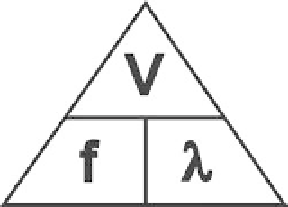Geology Reference
In-Depth Information
The calculations should be straightforward but, because GPR velocities are
usually quoted in m ns
−
1
and frequencies in MHz (Table 10.1), it is easy to
lose a few powers of ten unless orders of magnitude are appreciated. The
wavelength of a 100-MHz signal in air is 3 m, in rock with velocity 0.1 m ns
−
1
is 1 m, and in salt water, where
V
=
0.01 m ns
−
1
, only 10 cm. A useful way of
remembering the relationship between the key radar parameters is provided
by the
V
/
f
/λ
triangle:
If the required wavelength and material dielectric properties are known,
then the required signal frequency can be calculated by dividing the velocity
by the wavelength. Similarly if the source frequency is known as well as
the transmission velocity, then wavelength can be deduced by dividing the
velocity by the frequency.
10.1.2 Reflection of radar pulses
If a GPR signal encounters a discontinuity in either permeability, conduc-
tivity or permittivity, some of the signal will be reflected. The amount is
determined by the size of the target, the angle of incidence and the
am-
plitude reflection coefficient
for normal incidence on an infinite interface,
which, for low-conductivity, non-magnetic materials, is given by:
RC
=
(
√
K
2
−
√
K
1
)
/
(
√
K
1
+
√
K
2
)
=
(
V
1
−
V
2
)
/
(
V
2
+
V
1
)
K
1
and
K
2
are the complex permittivities of the host and target material
respectively. The
power reflection coefficient
, equal to (RC)
2
, is also some-
times used, but conceals the fact that there is a phase change of 180
◦
on
reflection from any boundary where permittivity decreases (and velocity
therefore increases). Reflection coefficients in most geological materials are
determined almost entirely by variations in water content, but conductivity
dominates for metals.
Reflection power is also governed by the nature of the reflector surface.
The strongest responses come from smooth surfaces, where specular reflec-
tion occurs (i.e. the angles of incidence and reflection are equal), but rough


